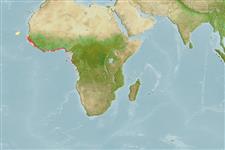>
Gobiiformes (Gobies) >
Gobiidae (Gobies) > Gobiinae
Etymology: Porogobius: Greek, poros = porous + Latin, gobius = gudgeon (Ref. 45335).
Eponymy: Hermann Schlegel (1804–1884) was a German-born zoologist who spent much of his life in the Netherlands. [...] (Ref. 128868), visit book page.
More on author: Günther.
Environment: milieu / climate zone / depth range / distribution range
生態学
海; 新鮮な水; 汽水性の 底生の; 両側回遊性 (Ref. 46888). Tropical
Africa: Senegal to Democratic Republic of the Congo (Ref. 7390, 57403, 79590, 80060). Also known from Cape Verde and islands in the Gulf of Guinea (Ref. 5299, 79590).
サイズ / 重さ / 年齢
Maturity: Lm ? range ? - ? cm
Max length : 18.9 cm TL オス/雌雄の選別がない; (Ref. 128374)
簡単な記述
検索表 | 形態学 | 形態計測学
背面の脊椎 (合計) : 7; 背鰭 (合計) : 9 - 10; 肛門の骨: 1; 臀鰭: 8 - 9. Diagnosis: each side of lower jaw with a recurved canine tooth approximately midway along its length (Ref. 57403). Outer row of teeth on lower jaw ending posteriorly in one or more long, recurved teeth (Ref. 79590). Angle of mouth reaching to below anterior margin of eye; 30-35 ctenoid scales in longitudinal series (including about 2-3 scales on caudal fin base), 9 scales in rearward transverse series; 1st dorsal fin: VI; 2nd dorsal fin: I,9 (infrequently 10); anal fin: I,8-9; pectoral fins: 19; pelvic fins just reaching to anus, relatively broad but with thin membrane between spines; caudal fin with 17 segmented rays (usually 14 of which are branched) (Ref. 57403, 79590).
Coloration: Preserved specimens: very pale (whitish in alcohol); body covered with numerous small, black spots, larger and more close-set on dorsum; lateral part of head with a dark band running in a crescent from above posterior tip of jaw up towards eye, continuing under ventral margin of eye, and extending posteriorly to dorsal edge of operculum; head with dark, median predorsal band; flanks, below lateral line, with several short vertical bars of fine black dots, darkest bars located at level of 2nd dorsal fin; pectoral fin with dark patch near base of upper rays; just posterior to this there is a band of dark pigment running posteroventrally down upper part of fin; lower, anterior part of pectoral fin bears a narrow, longitudinal, band of dark pigment; other parts of fin with fine black speckling; white longitudinal band along middle of each dorsal fin, and a black longitudinal band along middle of anal fin; pelvic fins with black pigment between rays; caudal fin speckled black, with some dark spots aligned in vertical or slightly oblique rows (Ref. 57403, 79590).
Occurs inshore, in the intertidal zone (Ref. 4343), in brackish and freshwaters, particularly estuaries, coastal lagoons, mangrove swamps (Ref. 4343, 57403, 79590), creeks and lower river basins (Ref. 57403). Tolerant of fresh waters and may ascend rivers, although less common in these habitats; may establish burrows in subtidal mud (Ref. 79590). Feeds on fish, lamellibranchs, phytoplankton and detritus (Ref. 28587).
Life cycle and mating behavior
成熟 | 繁殖 | 放精 | 卵 | 生産力 | 幼生
Harrison, I.J., P.J. Miller and F. Pezold, 2003. Gobiidae. p. 625-666 In C. Lévêque, D. Paugy and G.G. Teugels (eds.) Faune des poissons d'eaux douce et saumâtres de l'Afrique de l'Ouest, Tome 2. Coll. Faune et Flore tropicales 40. Musée Royal de l'Afrique Centrale, Tervuren, Belgique, Museum National d'Histoire Naturalle, Paris, France and Institut de Recherche pour le Développement, Paris, France. 815 p. (Ref. 57403)
IUCNのレッドリストの状況は (Ref. 130435: Version 2024-2)
Human uses
用具
特記事項
XMLをダウンロードして下さい
インターネットの情報源
Estimates based on models
Preferred temperature (Ref.
123201): 25.6 - 28, mean 27.4 °C (based on 163 cells).
Phylogenetic diversity index (Ref.
82804): PD
50 = 1.0000 [Uniqueness, from 0.5 = low to 2.0 = high].
Bayesian length-weight: a=0.00912 (0.00505 - 0.01647), b=3.01 (2.85 - 3.17), in cm total length, based on LWR estimates for this species & (Sub)family-body (Ref.
93245).
栄養段階 (Ref.
69278): 2.9 ±0.38 se; based on food items.
回復力 (Ref.
120179): 手段, 1.4年~4.4年の倍増期間の最小個体群 (Preliminary K or Fecundity.).
Fishing Vulnerability (Ref.
59153): Low vulnerability (10 of 100).
Nutrients (Ref.
124155): Calcium = 287 [156, 628] mg/100g; Iron = 1.26 [0.69, 2.39] mg/100g; Protein = 17.4 [15.5, 18.9] %; Omega3 = 0.155 [0.065, 0.317] g/100g; Selenium = 42.7 [21.4, 102.3] μg/100g; VitaminA = 26.8 [8.9, 71.3] μg/100g; Zinc = 2.14 [1.50, 3.10] mg/100g (wet weight);
